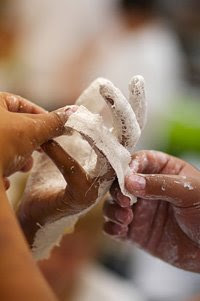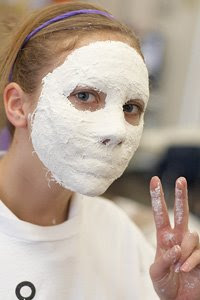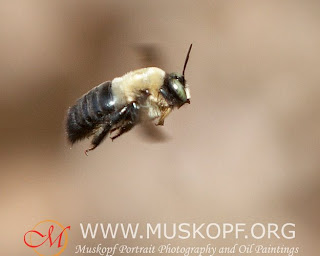Sunday, May 18, 2008
Embrace the Chaos
Friday, May 16, 2008
The Mission
The Mission
- To appreciate beauty
- To create images which express beauty
- To help others to appreciate beauty
I am a servant of Beauty, Peace, and Love.
My goals are achieved when my heart is warmed with the beauty of a landscape, a flower, or a smile; when I express beauty through the creation of paintings and photographs; and by helping others through teaching and sharing my work. When I create, I have fulfilled a primary reason for my existence. When others are generous enough to offer payment for my creations, this is a blessing which allows me to continue on my creative path. I am humbled by their support.
New paintings underway
Sunday, May 11, 2008
Remembering
I'm from the twinkling blue sky
peaking through green leaves
I'm from the damp, rich musk of the
forest floor after a rain
with the mud sucking at my boots
with a loud "glug" and "smack"
I'm from the sound of birds singing and squirrels
crashing like elephants through dry leaves
I'm from the steep hill, the fallen log
covered with moss over a cool stream
I'm from the sense of panic knowing
I'm in trouble again, not home in time
Late for dinner, not back before dark,
muddy again
I'm from the sad realization of more lawnmowers
fences, driveways, and dogs barking
Of knowing that my vast wilderness
became a tiny hill between neighborhoods
Thursday, May 8, 2008
Garden Safari
Sunday, May 4, 2008
Thinking about Learning
I put up the previous post to give a bit of background for this one. Fisher and Frey talk about learning as a transition from Teachers doing all the work to the eventual Student doing all the work. They argue that the hierarchy moves from Focus Lessons to Guided Instruction to Collaborative Learning and finally to Independent Learning where students have received modeled, guided, and collaborative learning experiences related to concepts needed to complete independent tasks. Independent tasks extend beyond practice to application and extension of new knowledge.
Stephen Covey, author of 7 Habits of Highly Effective People, puts forth the argument that personal development moves from a state of Dependence to a state of Independence and finally to a state of Interdependence. Covey is stating that people who are secure in themselves can synergistically blend their talents and ideas with those of others to create a whole that is greater than the sum of its parts.
I think it's interesting to wonder which is the most important, collaboration or independence. "Both" would be the easy answer. I think the real answer is something like this:
1. Focus Lessons: We need someone to get us started.
2. Guided Instruction: We need help getting started.
3. Collaboration: We need to work together to create something new and wonderful.
4. Independence: We are ready to independently experiment and hone our craft
UNTIL
5. Collaboration: When we hit a roadblock as an independent learner, we must share our ideas with others in order that this blending creates something new which overcomes the barrier.
THEN
6. Independence: We set out on our new path (until the next roadblock, then we go to collaboration again).
Thinking about my own learning in the past few years, most of it has been either collaborative or independent, and rarely has it been exclusively either one. In fact, I'd say that the times when I was most independent were probably the times when I repeated myself the most, thus creating my own roadblock. The times when I was most collaborative, I think I lost a bit of the self worth and pride that comes from independent achievement.
Both are necessary. Neither is superior.
Art Education: A look at learning
M. Todd Muskopf
May 3, 2008
Improving Student Achievement in the Art Classroom
This paper will discuss classroom procedures and concepts, which will allow teachers to inspire students to become eager participants in their own learning about Art. I will lay out some general guidelines, based on the work of Fisher and Frey and apply them to an example lesson. In this lesson, my 8th grade students create life-size mixed-media sculptures made from plaster casts taken from their bodies and added with various other media to depict a student-chosen subject. In this one lesson, we actually go through the first three phases of teaching, Focus Lessons, Guided Instruction, and Collaborative Learning. The last phase, Independent Learning, is encouraged in my classes, but by definition is worked on during after-school sessions or at home.
Task 1: Inspire (Focus)
Morale is the spirit by which Huns submit their services to the tribe. It is not uncontrolled celebration and romping around the campfire (Roberts, 1987, p. 36)
In Theory: When beginning a lesson, it is vital to build interest and enthusiasm for the lesson to make sure the students are paying attention. This could result from a description of what they are going to do, showing them an example of what has been done before, and challenge them to exceed what has gone before. Establish the purpose and context of the task in the art historical and the cultural contexts. Discuss the media to be used and the methods for using it, and how this project is unique to their grade level and that it is their privilege to be given this task. Explain the benefits and difficulties of the activity. Keep challenging them and building excitement. Go through a sample project out loud, modeling the step-by-step thought process of how one past student’s project was begun and brought to fruition. Encourage metacognitive awareness, teaching the students to think through their problems by examining the core issues. Above all, keep challenging the students and building their excitement.
In Practice: I begin this lesson with a warning that I only trust the 8th graders to do this project because it is costly and is potentially dangerous if done incorrectly (not really dangerous, but I play that up to get them excited). I describe the representative sculptures from the Greeks through the Renaissance and into the modern sculptures of George Segal, showing them photos to set an art historical context.
Task 2: Getting Started (Guided Instruction)
Chieftains must inspect their Huns frequently in order to see that what is accomplished meets with what is expected (Roberts, 1987, p. 63)
In Theory: With guided instruction, it is important to see small groups of students working together with a common purpose. These groups can be changed from project to project to effectively forestall conflicts or jealousies among students. The teacher is an activ
 e participant in the activity, and there is continual dialogue between the teacher and groups of students as ideas and techniques are defined and learned. The teacher uses open-ended questioning to facilitate student identification of core problems and help the groups to work together in solving them.
e participant in the activity, and there is continual dialogue between the teacher and groups of students as ideas and techniques are defined and learned. The teacher uses open-ended questioning to facilitate student identification of core problems and help the groups to work together in solving them.In Practice: Students are broken into groups of two or three. One student will be the model to be wrapped and the others will do the wrapping. I will go from group to group, demonstrating proper techniques, asking questions to help the students problem-solve, being a timekeeper, and, above all, being a cheerleader. This is a complex, challenging project and the student’s self-motivation is critical to the project’s success.
Task 3: Synergy (Collaborative Thinking)
Leaders must encourage creativity, freedom of action and innovation among their subordinates, so long as these efforts are consistent with the goals of the tribe or nation. (Roberts, 1987, p. 62)
In Theory: Collaborative thinking occurs when the teacher has effectively removed himself from an active role and the student groups take charge of their own learning. The stage has been set, the action is in motion, and the teacher is now in the role of a consultant, observer, timekeeper, and, of course, cheerleader. The hard work of learning and problem solving at this point is done by the students with minimal teacher input. The students are working together in a synergistic manner, each contributing to the success of their partners as well as their own success.

There are times when neither the teacher nor the student knows for sure what’s going to happen. In the beginning, there’s a safe environment that enables people to be really open and to learn and to listen to each other’s ideas. Then comes brainstorming, where the spirit of evaluation is subordinated to the spirit of creativity, imagining, and intellectual networking. Then an absolutely unusual phenomenon begins to take place. The entire class is transformed with the excitement of a new thrust, a new idea, a new direction that’s hard to define, yet it’s almost palpable to the people involved. (Covey, 2004, p. 265)
In Practice: When the groups are experienced enough that they need little guidance, I step back and let them work things out for themselves. My job at that time is to maintain the materials, make sure the proper schedule is followed, etc. Questions from the students are fewer and it generally comes down to letting them bring their dreams into reality.
Task 4: Independent Learning
Wise chieftains grant both authority and responsibility to those they have delegated assignments. (Roberts, 1987, p. 74)
In Theory: Students who have been taught the procedures for doing tasks need to complete these independently. Independence fosters experimentation and allows for personal bias to direct learning. The teacher is available to conference concerning the independent work as well as evaluate it when applicable.
In Practice: My students are assigned a few drawing assignments per quarter which are to be done out of class. The students are given a topic, but the topic is very broad, so as to foster variation and independent thought. They are given a rubric which specifies that they will be graded on showing details (depict representational subject matter effectively), shading (the gradual shift from light to dark to show 3-dimensional form), composition (effectively arranging the items in the picture), creativity, and effort. The students are also encouraged to do and turn in unassigned drawings which will be discussed and will count as extra credit. Furthermore, I stay after school on Mondays and Tuesdays and students are free to stay and work independent projects.
Conclusion
Studying Fisher and Frey’s concept of teacher responsibility and student responsibility shifting has been of benefit to me to identify and clarify some of the things that I’ve already been doing in the classroom. In lower grades (K-2), my classes tend to focus on Focused Lesson and Guided Instruction, in middle grades (3-6), I tend to use Focused Lesson, Guided Instruction and Collaborative Learning, and in the upper grades (7-8), I use all four types of Focused Lesson, Guided instruction, Collaborative Learning, and Independent Learning. I hope in the future to apply more of the Collaborative and Independent models with younger students in the future.
References
Covey, S. (2004) The 7 Habits of Highly Effective People, Free Press, (Original work published 1989.
Fisher, D. and Frey, N. (2008) Better Learning Through Structured Teaching, A Framework for the Gradual Release of Responsibility. ASCD,
Fisher, D. (2006) Creating Literacy-Rich Schools for Adolescents, Available Online at http://www.k12.wa.us/Conferences/JanConf2008/JanConfMaterials/DouglasFisher/Spokane-DougFisher.ppt
Roberts, W. (1987) Leadership Secrets of Attila the Hun, Warner Books.
Friday, May 2, 2008
Photographing Artwork
Have the painting placed vertically on a wall (not leaning against something or inclined on an easel). Check it with a bubble level. I've painted the wall I shoot against a dark matte color so it doesn't reflect into the lens.
Make sure camera is placed on a sturdy tripod and use a shoe-mounted bubble level to make sure the camera is also level.
My favorite lens for shooting artwork is my 85mm f/1.8. It's very sharp and doesn't distort the edges of the work. I shoot at f/8, ISO 100.
Use hot lights at 45 degree angles to the artwork. You can see if you are getting specular highlights off the artwork. Flag off light if necessary. Make sure the light covers the artwork evenly.
Use a cable release and mirror lock-up to minimize camera shake.
Use a gray card and something to use as a white and black point to the side of the artwork to make sure your exposure is correct. Shoot RAW and adjust color and exposure in post-processing.
Adjust shutter speed for available light.
Click.
Thursday, May 1, 2008
New Products


Podcasts
Here's a list of my favorites:
Lightsource
ProPhotographyShow
CandidFrame
Creative Lube
Chase Jarvis
Lenswork
Check them out on iTunes. You'll be happier. If you have a favorite I haven't listed, please list them in the comments. I love finding new cool podcasts.
BIF

Gearheads Begone!
I find lots of folks out there who, even after having had SLRs or DSLRs, are still in this "gearhead" phase of checking out what everyone else has. They think "if only I had THAT combination, then I'd be able to take the photos I want! This goes for bodies, lenses, tripods, software, etc. In fact, the first question I get if someone walks up to me when I'm out somewhere shooting is "what kind of camera is that?". I can see the checklist forming in their mind: My Stuff/His Stuff--who's is better?--who will win? [FYI: I'm being a little extreme here with my writing to exxagerate the point. I've just been waylayed a number of times and have missed shots while trying to be nice to people who would like nothing better than to chat about gear] In order to prevent this, I've actually taken gaffer tape and taped over the markings on my camera bodies and lenses. It's really funny to walk through a crowded event and see lots of people craning their head to try to figure out which brand/body/lens combos I'm using. The big white lens on the 70-200 gives that one away, but the others are tougher to figure out. When they ask me what cameras I'm using, I just say "Canon". That's enough for most of them, and I suspect that they automatically assume I have the latest and greatest model. Silly.
My advice on gear:
DSLR BODIES: At low ISO ratings (100, 200, even 400), you're not going to notice much difference between models in the same brand--unless it's Nikon, because their older cameras didn't do so well at 400 and above, whereas the new ones are nice). Buy what you can afford and buy the next one only when your present one will not give you what you need. Even the earliest dslrs would make great 8 x 10 prints. If that's all you're shooting, don't worry about getting the latest and greatest. In the past few years, we went through some new product offerings where it was the same camera as the previous model, but with a bigger LCD. Big whoop. The newest rounds are adding Live View (nice, but unless you're shooting tethered how much are you really going to use it?) and sensor cleaning (shake, shake, shake, but really, how hard is it to clean a sensor? Come on, it's a gimmick). As they pack more pixels into the same size sensor, the real challenge for manufacturers is to keep the image quality and noise reduction EQUAL to previous models, not better than previous models. That being said, a 10 MP image of equal quality is better than an 8 MP image if you're going to be printing it huge--say 20 x 30 or more. If you're printing 8 x 10's or 11 x 17's, you're not going to see much difference. Will you be able to strut a bit more if your camera is the newest?--sure. Will it make you a better photographer?--probably not.
LENSES: Here is where I will tell you that spending the extra money is definitely worth it. Get good glass. You may not need the best stuff, but stay away from the cheapest. When buying lenses, you should first decide what you intend to shoot. If it's going to be a lot of available light stuff, then a lens with a wide aperture (f/1.4-f/2.8) is going to be great, because you'll have more control and get a higher shutter speed with these lenses. Beware though, that some of these lenses (like the Canon 50mm 1.4) are really soft until you stop down to f/2.0 or better. Just because you can shoot at f/1.4 doesn't mean you should. If you're going to be shooting outside, or using flash all the time, you can spend less money and get an f/4 lens and it'll work out fine for you. You'll probably start out with a kit lens (18-55 or so). After that, decide what you want--wider field of view, more telephoto, etc. and let your needs guide your purchases. Don't buy things to build a collection.
TRIPODS: I can't believe what people spend on tripods. Carbon Fiber is all the rage right now, since it's so light and high-tech. Personally, I can't understand why people would spend hundreds of dollars more to save a pound of weight when they're tromping through the woods. If you want to save a pound of weight, eat less pie the week before you go. :) NOTE: I got a message from a person who loves their CF tripod. I'm sure they're very nice. I suppose I'm just too frugal.
Some considerations for tripods would be--LEGS: do you need the independent legs, or would you rather get the legs that connect to each other? I have Benbo Trekker aluminum legs and I love them. I've used them for 5 years in all types of terrain ranging from the ocean, to rocks in rivers, to steps, etc. and the legs always find a good foothold. Reasonably priced and stable.
SIZE: Not all tripods will fit in your luggage, and you'd better plan for the tripod to be in your packed luggage when flying. I bought a cheap set of legs from Amvona (on Ebay) because they're small when packed up, yet extend to a comfortable working height. It's not the greatest, but for something I'm mainly going to use submerged in salt water, that's fine with me.
WEIGHT: For tripods, weight=stability. An ultralight tripod is going to blow over (with your camera attached) in a high wind or if it gets bumped. Getting a tripod with a hook at the bottom of the center post to attach weight to it works, but you have to remember to use it every time.
HEADS: I've got a lot of different tripod heads, each with different purposes. My favorite is a Manfrotto 322RC pistol grip ball head, which I use either on a monopod or on a tripod. It's fast and solid. In the studio, I usually use a tilt/pan head, because it's easier to make fine adjustments.
STRAPS: I recommend the OP/Tech camera straps with the quick release buckles. They're great when you're using multiple cameras all day long. Those woven straps that come with cameras are awful after a few hours.
VEST: I've got a Domke vest and love it. Nuff said.
BAGS: I have a few different Lowepro backpacks and a Tamrac 5405 shoulder bag. I use the backpacks to carry large amounts of gear, but when it actually comes time to shoot, I pull out what I want, put it in my vest, and leave the backpack in the room or in the van. Walking around with a big backpack full of all the stuff you "might" need is not a good thing. The Tamrac 5405 is a nice little bag for carrying one cam with a shorter lens along with my phone, PDA, dig voice recorder, and other small gadgets. I carry this around wherever I go. It does get heavy after a few hours and cause some shoulder pain, so I bought the Domke mail carrier pad and that helps a lot.
CF CARDS: I like the Sandisk Ultra IIs. They work. I've had problems with Lexar and Kingston, so I don't even consider them. To keep my CF cards, I use a Think Tank Pixel Pocket Rocket (dumb name--nice product). It holds 10 cards and folds up nicely with a lanyard which I clip to my vest loop for added security.
BATTERIES: SterlingTek is a great little company. I've been using their batteries for 5 years. The couple of times there were problems, they replaced the batteries without hesitation.
